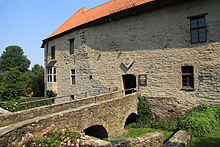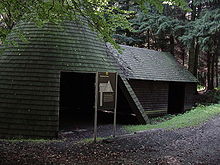Herbede
|
Herbede
City of Witten
|
|
|---|---|
| Coordinates: 51 ° 25 ′ 20 ″ N , 7 ° 16 ′ 54 ″ E | |
| Area : | 23.97 km² |
| Residents : | 13,111 (June 30, 2015) |
| Population density : | 547 inhabitants / km² |
| Incorporation : | 1st January 1975 |
| Postcodes : | 58452, 58456 |
| Primaries : | 02302, 02324 |
|
Meesmannstraße (main street until 1975), Herbeder pedestrian zone
|
|
Herbede is the largest district of Witten with an area of around 24 km² . It is located about 5 km southwest of Witten city center on the left side of the Ruhr on the edge of the Rhenish Slate Mountains and the Kemnader See . The shopping street Meesmannstraße forms the center of the town . Herbede has about 13,100 inhabitants.
geography

Herbede is located directly on the Ruhr and the Kemnader reservoir with large open spaces , leisure activities and numerous cycling and hiking trails . In the south there are hilly, larger contiguous forest areas that form the transition to the Sauerland and Bergisches Land . Essen , Bochum and Dortmund can be reached in a few minutes.
District structure
The Herbede district consists of five districts, so-called “statistical districts”, which are provided with numbers. It is a matter of
- 81 Herbede site
- 82 forewood
- 83 Bommerholz-Muttental
- 84 through wood
- 85 Buchholz champions .
Between 1951 (granted city rights) and 1975 ( incorporation of Herbedes by Witten ), the city of Herbede consisted of the districts of Herbede-Ort, Vormholz, Durchholz, Bommerholz, Kämpen and Buchholz (from 1970).
history
Herbede was first mentioned in a document in 851 as Villa Herribeddiu . In 1032 the church of St. Vitus, which belongs to the Deutz Abbey , was built. House Herbede was first mentioned in documents in 1208, a Ruhr bridge near Herbede was first mentioned in 1347. In 1589 the Reformation entered Herbede. A school for the parish was built in 1606. In 1683 Herbede received the right to hold a weekly market . However, due to opposition from the neighboring cities of Witten and Hattingen , this right was withdrawn in 1689.
The Herbeder lock was put into operation in 1780. The manufacturer Friedrich Spennemann erected two hammers in 1783. The Herdegen steel and iron factory started operations in 1788. A new lock was built in 1811, a post office opened in 1828 and a rolling mill in 1860 . The Ruhr Valley Railway connected Herbede with the Rhineland from 1868 onwards. The Herbede office was founded in 1886, which included East and West Herbede, Durchholz , Vormholz and Heven . Parish vicar Johannes Wächter built a sister house together with Franciscan nuns in 1889 , which also served as an orphanage . It was connected to the water supply network in 1894, and Herbede was electrified in 1906 .
On April 1, 1926, the municipality Herbede was formed from the municipalities Durchholz, Vormholz, Ostherbede and Westherbede. The gas supply network was put into operation in 1927. On the occasion of the 1100th anniversary Herbede received city rights on July 14, 1951 . As part of a regional reform on January 1, 1970, the Buchholz district of the previous town of Blankenstein was incorporated. In 1971 the section of the A 43 was released. On January 1, 1975 Herbede was incorporated into Witten . The Kemnader See was opened in 1980. Bruno J. Sobotka and friends founded the Friends 'Association Haus Herbede in 1982 , today the Friends' Association of Witten Herrenhäuser . The later Cardinal Franz Hengsbach opened the St. Josefshaus geriatric center in 1985. The first Herbeder Oktoberfest took place in 1986, and the city festival has attracted many visitors ever since. After extensive restoration work, the Herbede house was opened to the public in 1988. After the partial disintegration of the walls and the temporary use as a house, it has since served as a stage for cabaret and exhibition space for visual artists.
education
There are two universities in the direct catchment area of Herbedes ( Witten / Herdecke University , Ruhr University Bochum ).
Infrastructure and economy
traffic
Rail, tram and bus transport
The PT is ensured in Herbede through the bus lines 320, 374, 375, SB 38 and SB 67th The regional train station in downtown Witten can be reached in 16 minutes, the next long-distance train station in Bochum in a little over 30 minutes.
In the outskirts of Herbede there is only a rudimentary bus network due to the sparse population. The attempt to set up a citizens' bus failed in 2006 due to a lack of active support from the population.
From April to November, the museum railway “RuhrtalBahn” serves the two Herbeder stops “Witten-Herbede” and “ Ruine Hardenstein ” on a few days .
Streets
Herbede is connected to the trunk road network by the federal motorway 43 .
economy

- GLORIA Haus- und Gartengeräte GmbH
- Pleiger GmbH, mechanical engineering , electronic machine controls and plastics technology
- boesner GmbH holding , artist supplies , company operating beyond Germany
- Friedr. Lohmann GmbH , plant for special and stainless steels
Citizenry
The Citizens' Circle Herbede eV goes back to an initiative of private and business people in March 2003. The association was officially founded on July 11, 2005. As a common platform for everyone who wants to get involved in Herbede, individual citizens, associations, communities, schools, companies, churches, but also political parties, the citizens' group wants to contribute to the interest in the development To promote Herbedes and to develop and implement ideas for the common living space. The functionalities of the Herbede district are to be preserved, the economic development of the district to be strengthened and the supply structure to be supplemented and further improved. Via the citizen group as a common platform for civic engagement, the expertise and local knowledge of the Herbed citizens are to be activated more strongly for the future development of the place and to flow into the political decisions. In this way, the citizens' group wants to contribute to the transparency of political processes and the rationality of decision-making.
The citizenry employed the "Dorfmeister Herbede" (caretaker in the village) and for years has been opposed to the development of a fallow area adjacent to the center (Gerberviertel) with a full food supplier . For the second time a referendum is being initiated, according to which the city council, contrary to the factual arguments, has repealed existing agreements and has now released this area for the establishment of a food market. The citizen group, the Herbede local history association, residents and actors of the place fear the destruction of the center and further disadvantages for the development of the district.
media
The media offer corresponds to the media offer of the city of Witten . In addition, Herbede includes:
- Image (monthly magazine with a focus on Herbeder retail)
- Der Herbeder (monthly advertising magazine with a focus on city history , associations and local politics).
Both publications appear in the Herbede-Mitte , Buchholz and Kämpen districts , in Vormholz and Durchholz and outside Herbedes in Lake .
Culture and sights
In Herbede you can find the oldest building in Witten with the former noble residence Haus Herbede from the 12th century.
In Herbede there are several piers for the passenger ship Schwalbe II , which only operates between Lake Kemnader and Bommern in the summer months. With the start of the season at the beginning of April, bridal couples can charter the “Schwalbe” to get married on board. The operators of the "Schwalbe" are Stadtwerke Witten .
Herbede (Ostherbede and Vormholz districts) also includes the area of the Hardenstein nature reserve with the Hardenstein castle ruins and parts of the Muttental mining trail . In the vicinity of the ruins, the Hardenstein runs between the southern Herbeder Ruhr side and the northern Hevener Ruhr side, on which the Herbeder lock is located.
In 2007 Herbede is one of the fewer and fewer districts in the Ruhr area that still have a classic center with owner-managed retail stores .
The listed Evangelical Church is also worth seeing .
literature
- Bruno J. Sobotka : Herbede yesterday, today, tomorrow . Edited by the Herbede Local Authority and Tourist Office, Witten 1981, ISBN 3-9800432-1-5 .
Web links
Individual evidence
- ↑ a b c Information on the area and the population of the districts ( Memento from April 11, 2015 in the Internet Archive )
- ↑ a b Stephanie Reekers: The regional development of the districts and communities of Westphalia 1817-1967 . Aschendorff, Münster Westfalen 1977, ISBN 3-402-05875-8 , p. 244 .
- ↑ Martin Bünermann: The communities of the first reorganization program in North Rhine-Westphalia . Deutscher Gemeindeverlag, Cologne 1970, DNB 456219528 , p. 112 .
- ^ Federal Statistical Office (ed.): Historical municipality directory for the Federal Republic of Germany. Name, border and key number changes in municipalities, counties and administrative districts from May 27, 1970 to December 31, 1982 . W. Kohlhammer, Stuttgart / Mainz 1983, ISBN 3-17-003263-1 , p. 330 .








